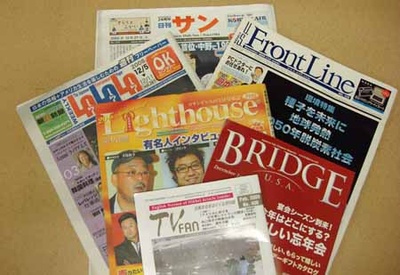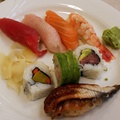Previously, I worked as an editor and writer for a free Japanese magazine in Los Angeles. When I joined the company in the late 90s, the only free Japanese magazines available at Mitsuwa (then Yaohan) and Nijiya Market that still existed were "Lighthouse," "Bridge USA," "US Frontline," "TV Fan," and "Nikkan Sun." Free magazines that have been discontinued include "VOGA," "Gateway USA," and "Marjoram." The serious newspaper "US Japan Business News" was acquired and has now changed its format.
Nowadays, free magazines are available at every station in Japan, but only 10 years ago, I think Japanese people would not have believed in "free magazines". Soon after, the Internet spread, and "information is free" became common sense. Furthermore, magazines can be produced with just advertising money, and the backstories of the industry were once openly known, and with the advent of DTP using computers, people can participate in publishing even if they have no knowledge of editing or printing, which are the main reasons for the mass production of free magazines.
The first free magazine in the Japanese community in Los Angeles was Gateway USA, which was founded in the mid-1970s (later discontinued). Lighthouse and Bridge USA, which are still representative of free magazines, were both launched in 1989, at the height of Japan's bubble economy. At the time, the Japanese community in LA had paid papers such as Rafu Shimpo (launched in 1903 and still in existence today) and California Mainichi (discontinued), which attracted subscribers mainly from first and second generation Japanese. It should be noted that the Nikkan Sun also charged for publication until the mid-1990s.
In the 1990s, the existence of free magazines became established and their quality improved dramatically. The selection process began, with some free magazines disappearing and new ones being born. There was also a trend of former employees of long-standing free magazines working on new free magazines.
According to the Los Angeles Consulate, the number of Japanese residents in 2007 was about 61,000, including LA and Orange counties. This is the number of voluntary residence notifications, so the actual number is likely to exceed 100,000. In addition to the five companies mentioned above, several other magazines, such as Weekly LaLaLa, Lovest, HapiHapi, and JP, are published in an effort to get a share of this pie. General lifestyle magazines can no longer compete with existing free magazines, so they are characterized by narrowing down their target audience to students, women, mothers, etc.
From the mid-90s, free English magazines introducing Japan, such as "Sushi & Sake" and "Cultural News," were launched. While these focused on traditional Japanese culture and food, recently it has become possible to see free English magazines that specialize in introducing Japanese subcultures such as manga. Furthermore, free magazines introducing Japanese culture written in Chinese have also appeared. There is a high aspiration to widely publicize Japanese culture to people other than non-Japanese people, and behind this lies the aim of expanding the number of advertising clients, which is currently limited to Japanese people.
Even after 2009, Japanese free magazines will continue to become more internationalized and fragmented. The economic downturn is the biggest enemy of free magazines that rely on advertising, but I hope they can do their best. In a Japanese community that is constantly said to be lackluster, I think that active Japanese free magazines are like our cheering squad.
© 2009 Yumiko Hashimoto











